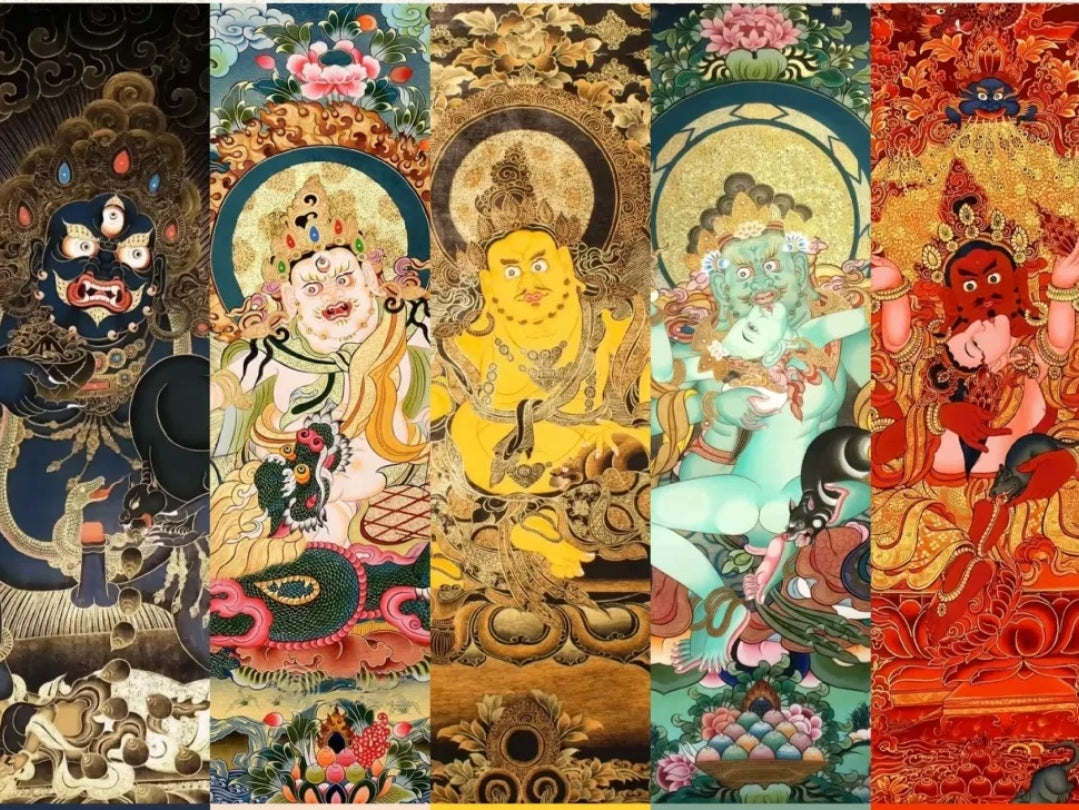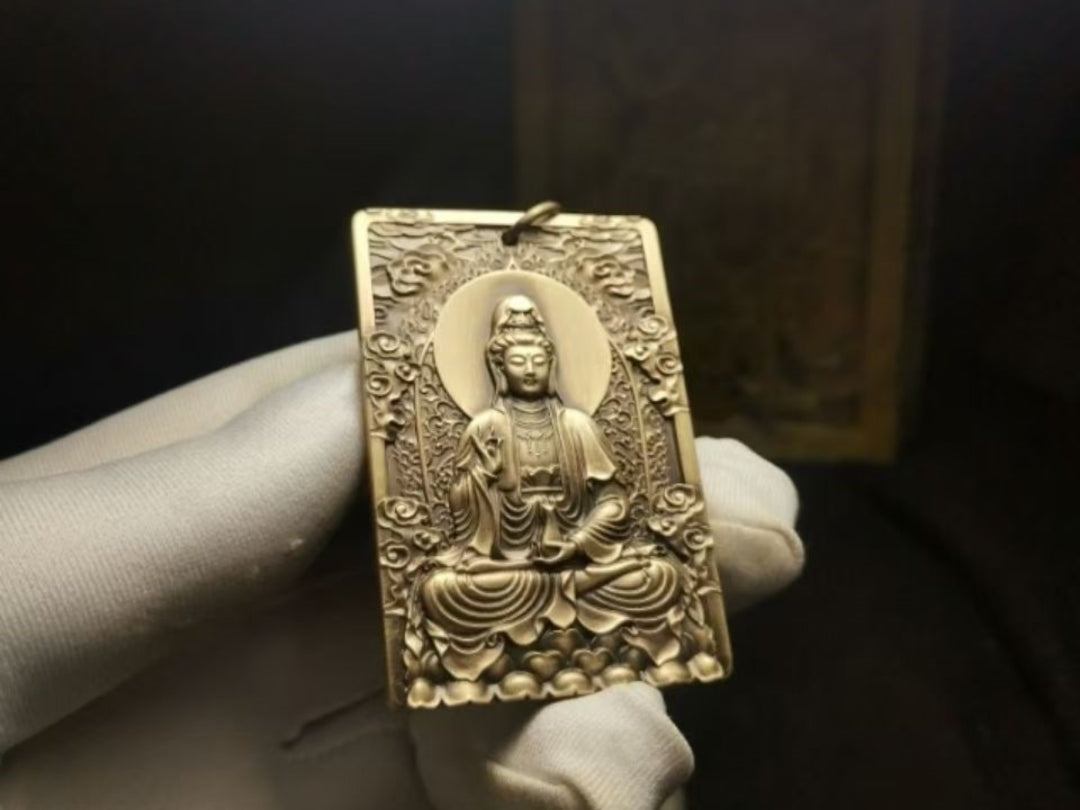Tibetan Buddhist tradition honors a rich pantheon of wealth deities who symbolize both material abundance and spiritual good fortune. Devotees honor these gods in temples and home shrines through mantras, offerings, and rituals. Common sacred symbols of fortune—like the treasure vase—are believed to magnetize wealth and abundance for the household. In the following sections we explore key Tibetan wealth deities—from Yellow Jambhala (the golden Buddha of riches) to Zakiram (the temple goddess of fortune)—explaining their origins, iconography, and role in cultural prosperity rites.

The Five Jambhalas: Five Forms of Wealth
Tibetan Buddhism describes five Jambhalas—Yellow, White, Green, Red, and Black—each an emanation of a Buddha or Bodhisattva dedicated to ending poverty.
-
Yellow Jambhala (Ratna Buddha family) is the chief wealth deity, symbolizing generosity and prosperity.
-
White Jambhala (an Avalokiteśvara emanation) pacifies obstacles to abundance.
-
Green Jambhala (Amoghasiddhi) activates success and swift achievement.
-
Red Jambhala (Padma family) magnets good fortune and entrepreneurial energy.
-
Black Jambhala (Akṣobhya family) uses fierce power to protect one’s assets.
Together, these five forms work in harmony to bring auspicious circumstances and generosity to practitioners.
Yellow Jambhala – God of Fortune and Prosperity
Yellow Jambhala is the most popular Tibetan god of wealth. Described as an emanation of Ratnasambhava and sometimes identified with Vasudhara or Vaisravana (Kubera), he sits on a lotus or treasure mountain. One hand holds a mani pearl (jewel), and the other holds a mongoose that spouts endless jewels. Worshippers recite his mantra “Om Jambhala Jalendraye Svaha” and offer water, incense, or gems. Practitioners visualize him radiating golden light to create a positive potential for wealth and abundance, while cultivating generosity and compassion.

Vasudhara: The Stream of Gems
Known as the goddess of wealth and abundance, Vasudhara is often depicted in green‑gold robes carrying a pot overflowing with jewels. Particularly popular in Nepal and Tibet, she is honored with the mantra “Om Vasudhārāyai Svāhā.” Devotees seek her blessings for fertility, success in ventures, and generosity. Offering small pots filled with coins or water on a shrine symbolizes the wish for both material prosperity and spiritual wealth.

Vaisravana: Protector and Lord of Riches
Vaisravana, one of the Four Heavenly Kings, is revered as the lord of wealth and guardian of the northern direction. Drawing on Hindu Kubera imagery, he rides a snow lion and carries a parasol and mongoose. In Tibetan practice, Vaisravana is often identified with Yellow Jambhala, linking local royal-giving symbolism with Vajrayāna teachings about generosity and protection.

Zakiram: Lhasa’s Unique Wealth Goddess
Zakiram, or Zha Ji La Mu, is a distinctive protector goddess venerated at Zha Ji Temple in Lhasa—Tibet’s only shrine dedicated to a wealth deity. According to legend, she was once a Qing‑era Chinese consort who, after tragic betrayal, was ritually transformed into a Tibetan guardian goddess. Her iconography includes dark skin, a black tongue, and chicken‑claw feet, reflecting stories of poison and dismemberment that she overcame through her divine power. Devotees present offerings of white wine, khata scarves, and incense, especially on Wednesdays, to invoke her blessings for safety, success, and prosperity.

Other Prosperity Figures
In addition to these principal deities, Tibetan Buddhists sometimes honor other figures:
-
Padma (Lakshmi) and Ganapati (Ganesha) in certain Vajrayāna lineages.
-
Folk gods, jade charms, endless knots, and auspicious fish or cranes in local belief.
These sacred symbols of fortune reinforce the idea that wealth in Buddhism is a gift to be shared, not a means for greed.
Prosperity Rituals and Symbols
Common prosperity practices include:
-
Pouring water or rice over a Jambhala statue.
-
Chanting wealth mantras and making offerings of gold, gems, or food.
-
Keeping a consecrated treasure vase in the home to magnetize abundance.
-
Visiting temples like Zha Ji Temple or Jambhala shrines and making donations.
-
Observing auspicious days—such as Tibetan New Year or specific deity days—to perform pujas.
Most rituals emphasize generosity: first stabilizing one’s own situation, then using wealth to help others, thus laying a strong foundation for compassion and community welfare.

Cultural Significance
Wealth deities in Tibetan Buddhism remind us that material blessings and spiritual growth go hand in hand. True prosperity practice leads to bodhicitta—the awakened heart—because when our own needs are met, we can better support and uplift others. Through temple worship, prayer flags, and sacred art, these gods of wealth remain woven into daily Tibetan life, guiding practitioners toward generosity, wisdom, and compassionate action.





